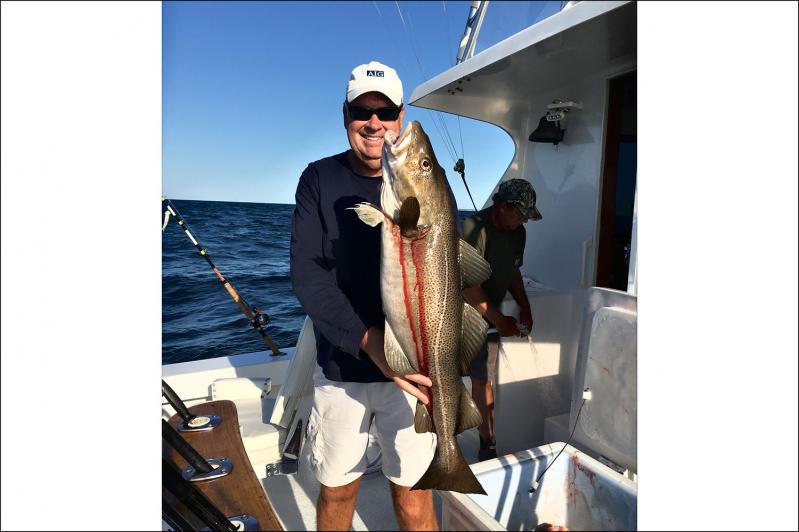It was sad. The news I read in a press release issued by the National Oceanic and Atmospheric Administration a few weeks ago made me recall great times pertaining to the most iconic fish in the world.
In short, the agency announced that it had closed the recreational fishery for codfish in all federal waters (three miles off the coast) south of Cape Cod as of May 1. For all intents and purposes, it’s game over.
Other than a two-week period where anglers may retain one cod per person, the fishery has been closed for several years north of Cape Cod and up to Canada. And for Newfoundland and Labrador well beyond that, it’s much more dire; a complete moratorium on cod goes all the way back to 1992.
The news for commercial fishermen here is not any better. Other than a very small trip limit in the Gulf of Maine, the commercial fishery for cod has been shut down as well.
Don’t even bother to bait a hook.
The season for cod will officially resume beginning on Sept. 1. But few will care. The nail has already been solidly hammered into the coffin. Sadly, even if the season were open, few would choose to pursue codfish.
For all practical purposes, the fishery is gone, and it’s not likely to ever return. It’s only a matter of time before a total moratorium is announced.
For centuries, since the era of the Vikings, codfish was a significant economic commodity and was the first major export from America. Of note, the Vikings and Basques were the first Europeans to harvest and cure cod. We’re talking well over 800 years of fishing history here. For a most interesting read, pick up Mark Kurlansky’s book “Cod: A Biography of the Fish That Changed the World.” It’s a true page-turner even for those who are not cod-heads.
At Montauk, the pursuit of codfish was an intense, yearlong activity for recreational and commercial fishermen for many decades. I loved to fish for them, and it became an obsession of mine for many years, whether the outdoor temperature was 10 or 90 degrees.
As illustration, I recall fishing one frigid day in January of 1989 on the Viking Starship, where the deck was four inches deep in slushy saltwater ice. Our rods and reels were thickly encased in crystallized ice when we anchored on a rock pile southeast of Block Island. On the bow of the ship where our rods were placed, we all had a hard time just getting our clam-baited hooks to the bottom below; our reels were jammed up from the ice. We had to use our fingers to manually remove the fishing line off our spools.
The wind chill that morning was minus 40 degrees. The National Weather Service issued several warnings of concern, basically saying it was dangerous to venture outdoors. But despite the harsh, arctic weather, the codfish and this fishing scribe remained oblivious to the adverse conditions. Truth be told, being young and dumb worked to my advantage; I didn’t even use gloves that day.
The action that day was excellent for those who were literally stuck to the rail. I recall that trip like it was yesterday. The cod were hungry.
On the opposite side, as recently as eight years ago, I recall a trip on July 18 on the Viking Five Star where the outdoor temperature reached 95 at Cox’s Ledge, about 35 miles southeast of Montauk.
There was no wind and we baked in the blazing hot sun. It felt like being in a sauna. I could not stop perspiring and would periodically shove ice cubes from my cooler down the backside of my shirt and on top of my head. And yet, we ended up the day with a decent catch.
And I still fondly recall my first trip for cod back in 1974 aboard the Peconic Queen III, a party boat out of Montauk that was run by the colorful Capt. Jimmy Behan. I was 13 and the fare was $25.
While those around me at the rail caught a large number of cod, I struggled. It wasn’t until the last hour of fishing that I landed the first cod of my life. Nothing could wipe the smile off my face. I was hooked.
In cod we trust.
A note of correction. Last week, I wrote that anglers can retain four fluke over 19 inches. In actuality, folks can only retain three. Also note that the size limit for fluke will increase to 19.5 inches on Aug. 2. The same bag limit will remain in place.
In happier news, the fishing has been great, especially for those to the west in the Peconics. There, porgies, weakfish, bluefish, and striped bass have been landed in great quantities. Squid, too, are being caught on jigs at night in Three Mile Harbor, Greenport, Sag Harbor, and other areas.
Out at Montauk, the striped bass have shown up en masse earlier than usual, much to the delight of many anglers.
“It generally has been a good beginning of May,” said Capt. Timothy O’Rourke of Montauk Point Fly Fishing. “The quality of the size is a bonus for sure. But the last few years the bass fishing has been really incredible.”
The light-tackle guide has put his patrons’ bass upward of 45 inches in length of late. It’s certainly a great start to the season.
—
Fishing tips, observations, and photographs can be sent to [email protected].

